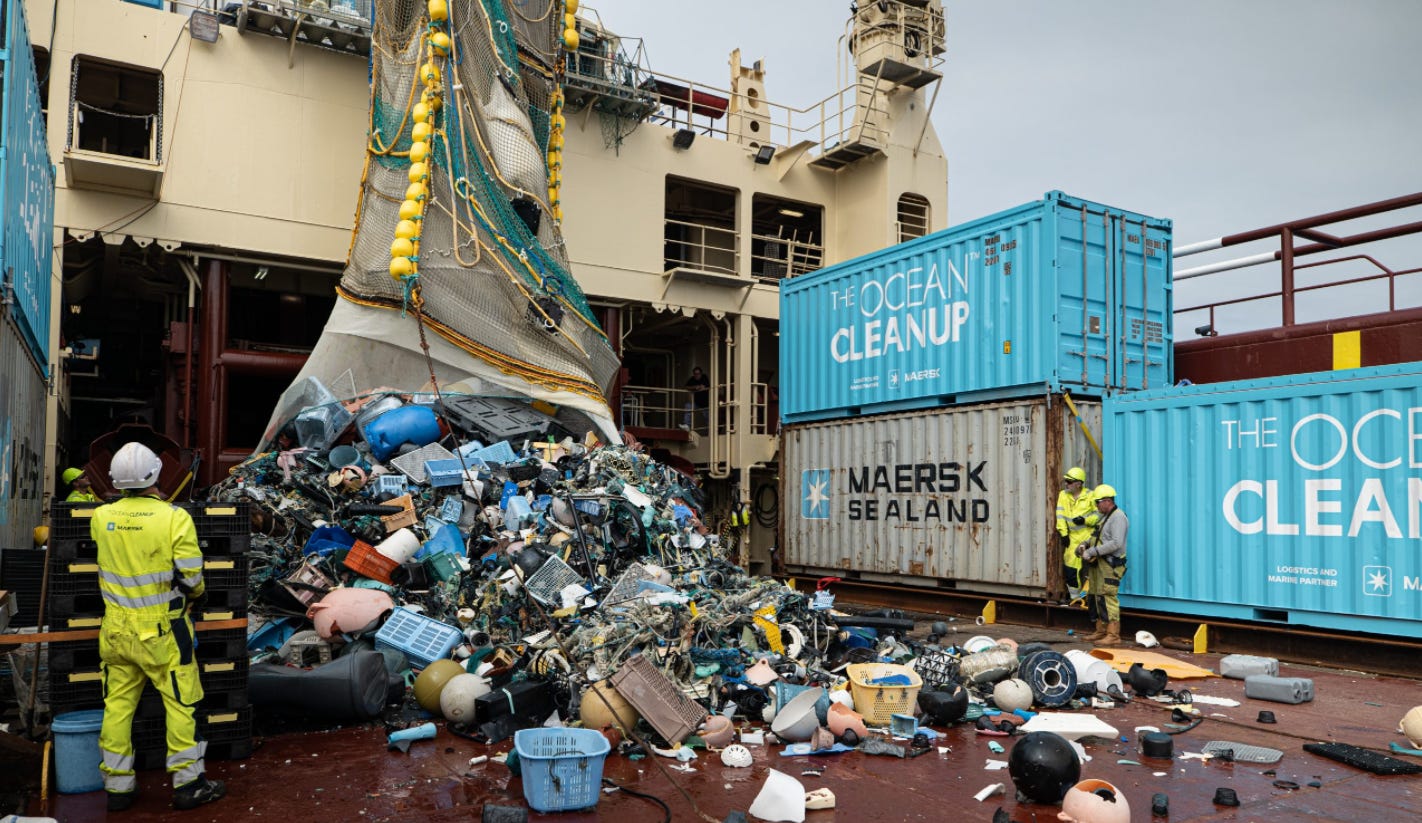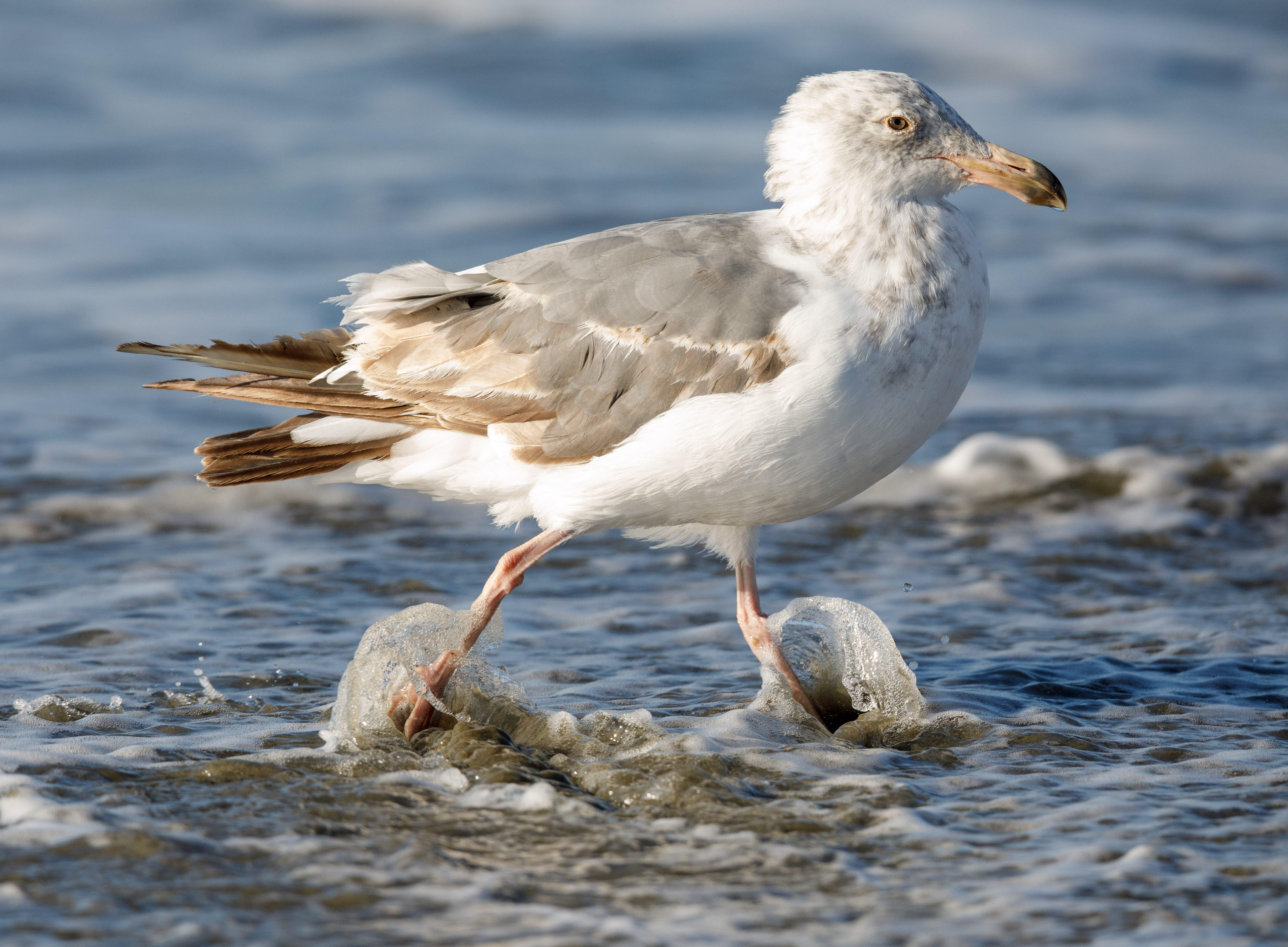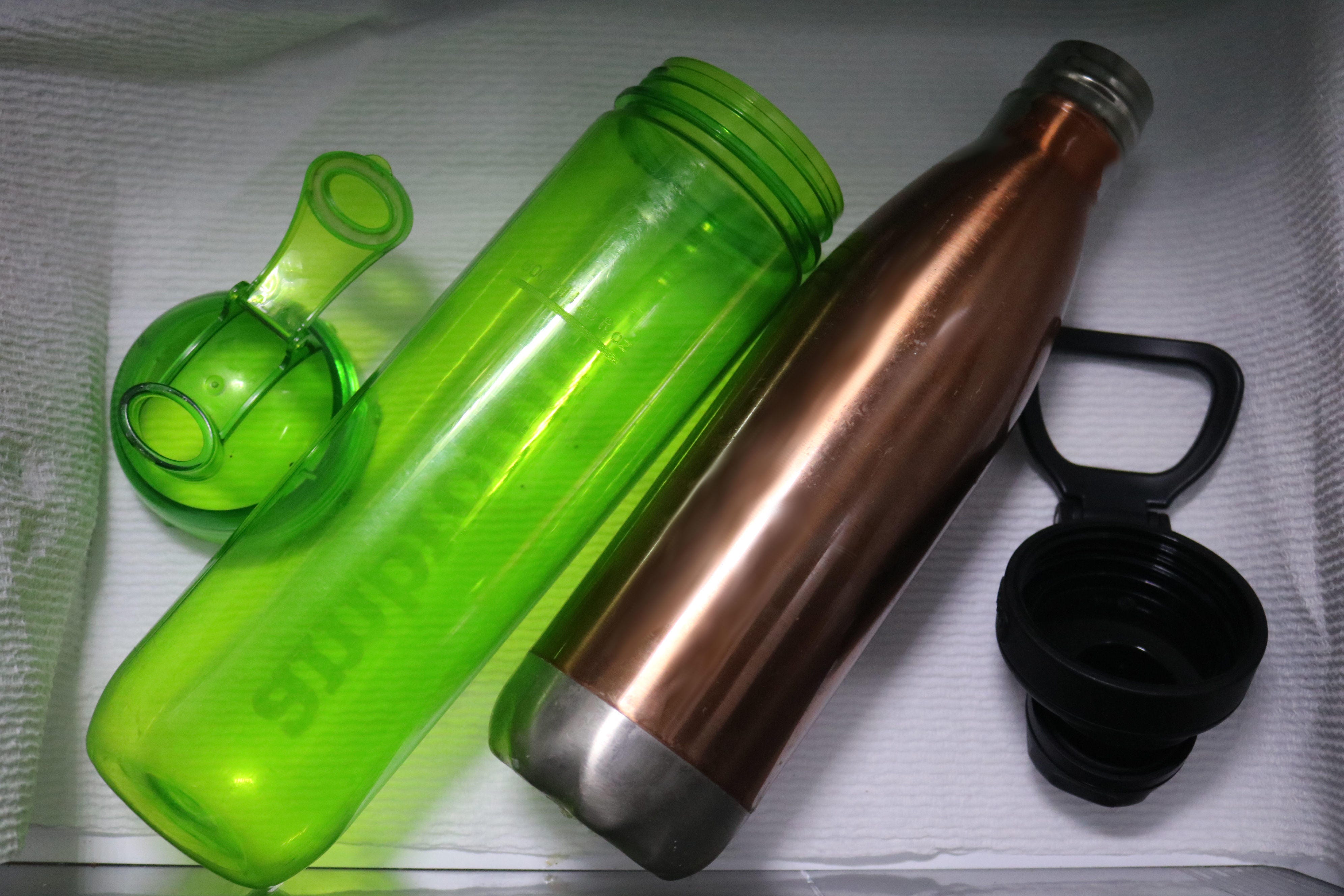Two large vortexes in the Pacific Ocean have collected trash over several decades. Here's where it's coming from.
Katie Teague
Nov. 3, 2021

Ocean trash is affecting marine life
.Ahmed Areef/EyeEm/GettyImages
Two floating islands of trash, together known as the Great Pacific Garbage Patch, are taking up a large chunk of real estate in the Pacific Ocean. The Patch is separated into two whirlpools of human detritus -- the Western Garbage Patch (closer to Japan) and the Eastern Garbage Patch (closer to California and Mexico).
The vortexes are primarily composed of land trash, like plastic bottles and straws, that's found its way into the ocean, but they also contain fishing gear that's been discarded into the sea. Although it's not as noticeable as you might think, the pervasive clumps of human-made garbage damage marine life, as well as the environment, and can even exacerbate human-caused climate change.
The trash extends for hundreds of miles, and in August the environmental nonprofit Ocean Cleanup deployed Jenny, its first large-scale cleaning system, which has since removed more than 63,000 pounds of trash. In October, Ocean Cleanup called that work the "beginning of the end of the Great Pacific Garbage Patch."
This news comes just in time for COP26, the United Nations Climate Change Conference, which lasts through Nov. 12. At the summit, roughly 200 nations are meeting in Glasgow, Scotland, to negotiate an updated agreement of the United Nations Framework Convention on Climate Change in an attempt to keep temperatures from rising 1.5 degrees Celsius above pre-industrial levels.
Plastic pollution and microplastics have been shown to contribute to climate change, since heat can cause them to release greenhouse gases. Addressing the climate crisis requires reducing pollution in the oceans, which collect 8 million tons of plastic yearly.
Here's everything we know about the island of trash in the Pacific Ocean and how you can help.

The Ocean Cleanup's goals include eliminating the Great Pacific Garbage Patch. Here is the outcome of one haul this fall.
What is the Great Pacific Garbage Patch?
The garbage patch is two vortexes filled with trash in the Pacific Ocean. They're also known as gyres, which is when two ocean currents come together and create a hurricane-like current, Nancy Wallace, director of the Marine Debris Program at the National Oceanic and Atmospheric Administration, told CNET. Materials then get caught in the gyres.
While you may think the patches are solid masses of tangled plastic, they're actually dispersed across hundreds of miles of the Pacific. You could sail through the patches without even noticing you're in them. This is because as much as 70% of the trash eventually sinks to the bottom of the ocean, Wallace said.
How large is the garbage patch?
The Ocean Cleanup estimates that the Great Pacific Garbage Patch occupies 1.6 million square kilometers, about twice the size of Texas, or three times the size of France.
However, the actual size of the island of trash is unknown due to a number of factors. For starters, not all of the trash sits on top of the water. It's estimated to span hundreds of miles, Wallace said, and it's a moving target due to waves and wind. It does, however, stay within a specific area due to ocean currents.
How much trash is in the garbage patch?
As of 2015, there was an estimated 8 million metric tons of plastic waste in the garbage patches, according to Wallace, although it's uncertain the exact amount going into the Pacific Ocean. That's the weight equivalent of roughly 57,000 blue whales, according to Conservation.org, which also projects that by 2050, the mass of ocean trash from plastic will outweigh its fish.
The Ocean Cleanup said it found more than 1.8 trillion pieces of plastic in the patch that weigh an estimated 80,000 tons.
At least 8 million tons of plastic enter all the oceans each year, and it's expected to double by 2030, according to the World Wildlife Fund organization.
Where did the trash come from?
Most of the trash comes from land in North America and Asia, while 20% comes from boats or ships that discard debris into the ocean, including lost fishing gear, according to the National Marine Sanctuary Foundation.
Trash can also eventually make its way into the ocean from land-based sources, such as rivers, storm water and littering.
How is the garbage affecting marine life?

A western gull wades along the Pacific coast in California. Animals can mistake plastics in the ocean for food.

Reusable bottles can help prevent more plastic bottles from going into the ocean.
What can I do to help clean up ocean trash?
Businesses and individuals should avoid adding to the problem. For instance, stop littering and start using reusable water bottles instead of single-serve plastic bottles that can easily wind up in waterways.
If you live near an ocean, volunteer to clean the shoreline to help remove debris on shores.
If you don't live near an ocean, you can help clean up parks or local neighborhoods, as trash in those areas can eventually end up in marine environments.
Donate to different organizations that support removing the trash, such as Ocean Conservancy and Oceana.
Shop at companies that are working toward sustainability. They'll typically have this info listed on their website -- for instance, Amazon has a sustainability page with its goals.
Attend COP26's Green Zone event (in person or virtually) to learn more about how the ocean plays a role in our climate.
Support people in all levels of the government who advocate policies addressing climate change.
For more information, read about how COP26 is the "world's best last chance" for climate action and why it's important. Also, scientists estimate 85% of the world's population is affected by climate change.
First published on Nov. 2, 2021
Two floating islands of trash, together known as the Great Pacific Garbage Patch, are taking up a large chunk of real estate in the Pacific Ocean. The Patch is separated into two whirlpools of human detritus -- the Western Garbage Patch (closer to Japan) and the Eastern Garbage Patch (closer to California and Mexico).
The vortexes are primarily composed of land trash, like plastic bottles and straws, that's found its way into the ocean, but they also contain fishing gear that's been discarded into the sea. Although it's not as noticeable as you might think, the pervasive clumps of human-made garbage damage marine life, as well as the environment, and can even exacerbate human-caused climate change.
The trash extends for hundreds of miles, and in August the environmental nonprofit Ocean Cleanup deployed Jenny, its first large-scale cleaning system, which has since removed more than 63,000 pounds of trash. In October, Ocean Cleanup called that work the "beginning of the end of the Great Pacific Garbage Patch."
This news comes just in time for COP26, the United Nations Climate Change Conference, which lasts through Nov. 12. At the summit, roughly 200 nations are meeting in Glasgow, Scotland, to negotiate an updated agreement of the United Nations Framework Convention on Climate Change in an attempt to keep temperatures from rising 1.5 degrees Celsius above pre-industrial levels.
Plastic pollution and microplastics have been shown to contribute to climate change, since heat can cause them to release greenhouse gases. Addressing the climate crisis requires reducing pollution in the oceans, which collect 8 million tons of plastic yearly.
Here's everything we know about the island of trash in the Pacific Ocean and how you can help.

The Ocean Cleanup's goals include eliminating the Great Pacific Garbage Patch. Here is the outcome of one haul this fall.
The Ocean Cleanup
What is the Great Pacific Garbage Patch?
The garbage patch is two vortexes filled with trash in the Pacific Ocean. They're also known as gyres, which is when two ocean currents come together and create a hurricane-like current, Nancy Wallace, director of the Marine Debris Program at the National Oceanic and Atmospheric Administration, told CNET. Materials then get caught in the gyres.
While you may think the patches are solid masses of tangled plastic, they're actually dispersed across hundreds of miles of the Pacific. You could sail through the patches without even noticing you're in them. This is because as much as 70% of the trash eventually sinks to the bottom of the ocean, Wallace said.
How large is the garbage patch?
The Ocean Cleanup estimates that the Great Pacific Garbage Patch occupies 1.6 million square kilometers, about twice the size of Texas, or three times the size of France.
However, the actual size of the island of trash is unknown due to a number of factors. For starters, not all of the trash sits on top of the water. It's estimated to span hundreds of miles, Wallace said, and it's a moving target due to waves and wind. It does, however, stay within a specific area due to ocean currents.
How much trash is in the garbage patch?
As of 2015, there was an estimated 8 million metric tons of plastic waste in the garbage patches, according to Wallace, although it's uncertain the exact amount going into the Pacific Ocean. That's the weight equivalent of roughly 57,000 blue whales, according to Conservation.org, which also projects that by 2050, the mass of ocean trash from plastic will outweigh its fish.
The Ocean Cleanup said it found more than 1.8 trillion pieces of plastic in the patch that weigh an estimated 80,000 tons.
At least 8 million tons of plastic enter all the oceans each year, and it's expected to double by 2030, according to the World Wildlife Fund organization.
Where did the trash come from?
Most of the trash comes from land in North America and Asia, while 20% comes from boats or ships that discard debris into the ocean, including lost fishing gear, according to the National Marine Sanctuary Foundation.
Trash can also eventually make its way into the ocean from land-based sources, such as rivers, storm water and littering.
How is the garbage affecting marine life?

A western gull wades along the Pacific coast in California. Animals can mistake plastics in the ocean for food.
Stephen Shankland/CNET
You've likely seen photos of sea turtles with fishing nets tangled around their bodies and shells. This is just one terrible effect that human-generated debris has on marine life. Animals in the ocean can also ingest the plastic debris, which can harm them and make them feel as though they're full, Wallace said. This results in the animals not eating the food they need to survive. The plastic could also lacerate their organs.
Plastic can choke and smother marine animals and their habitats and can take hundreds of years to break down, according to the WWF.
Microplastics also have a negative effect
Microplastics are less than 5 millimeters long and come from larger debris that breaks down into smaller pieces, so they're much harder to filter out. These small plastics can pose a threat to aquatic animals as they can ingest the debris.
But can eating fish that have consumed these microplastics hurt humans? Ocean Cleanup says when animals eat the plastics containing chemicals, there's a possibility the chemicals could eventually make their way up the food chain to people.
However, more studies are needed to determine the impacts of microplastics, according to the NOAA.
Is ocean trash contributing to climate change?
In short, yes. Chemical components and legacy pollutants absorb into the plastic the marine animals are eating, Wallace said. Then sunlight and heat cause the plastic to release powerful greenhouse gases. The WWF says as the planet gets hotter, the plastic breaks down into methane and ethylene, which increases the rate of climate change.
Ocean plastic damages air quality, pollutes the atmosphere and contributes to global warming, according to Iberdrola, a multinational electric utility.
Is anything being done to clean up the ocean trash?
Yes. Groups are working to prevent more trash from ending up in the garbage patches by reducing the number of single-use products, such as bottles and straws. There are also people working on cleanup and removal of debris on or near the shore because it's easier to get land trash picked up.
Other groups are looking at doing open ocean cleanup to collect debris like fishing gear and other smaller pieces that are floating around, but there are some challenges since the Pacific Ocean is so big and deep.
You've likely seen photos of sea turtles with fishing nets tangled around their bodies and shells. This is just one terrible effect that human-generated debris has on marine life. Animals in the ocean can also ingest the plastic debris, which can harm them and make them feel as though they're full, Wallace said. This results in the animals not eating the food they need to survive. The plastic could also lacerate their organs.
Plastic can choke and smother marine animals and their habitats and can take hundreds of years to break down, according to the WWF.
Microplastics also have a negative effect
Microplastics are less than 5 millimeters long and come from larger debris that breaks down into smaller pieces, so they're much harder to filter out. These small plastics can pose a threat to aquatic animals as they can ingest the debris.
But can eating fish that have consumed these microplastics hurt humans? Ocean Cleanup says when animals eat the plastics containing chemicals, there's a possibility the chemicals could eventually make their way up the food chain to people.
However, more studies are needed to determine the impacts of microplastics, according to the NOAA.
Is ocean trash contributing to climate change?
In short, yes. Chemical components and legacy pollutants absorb into the plastic the marine animals are eating, Wallace said. Then sunlight and heat cause the plastic to release powerful greenhouse gases. The WWF says as the planet gets hotter, the plastic breaks down into methane and ethylene, which increases the rate of climate change.
Ocean plastic damages air quality, pollutes the atmosphere and contributes to global warming, according to Iberdrola, a multinational electric utility.
Is anything being done to clean up the ocean trash?
Yes. Groups are working to prevent more trash from ending up in the garbage patches by reducing the number of single-use products, such as bottles and straws. There are also people working on cleanup and removal of debris on or near the shore because it's easier to get land trash picked up.
Other groups are looking at doing open ocean cleanup to collect debris like fishing gear and other smaller pieces that are floating around, but there are some challenges since the Pacific Ocean is so big and deep.

Reusable bottles can help prevent more plastic bottles from going into the ocean.
Alina Bradford/CNET
What can I do to help clean up ocean trash?
Businesses and individuals should avoid adding to the problem. For instance, stop littering and start using reusable water bottles instead of single-serve plastic bottles that can easily wind up in waterways.
If you live near an ocean, volunteer to clean the shoreline to help remove debris on shores.
If you don't live near an ocean, you can help clean up parks or local neighborhoods, as trash in those areas can eventually end up in marine environments.
Donate to different organizations that support removing the trash, such as Ocean Conservancy and Oceana.
Shop at companies that are working toward sustainability. They'll typically have this info listed on their website -- for instance, Amazon has a sustainability page with its goals.
Attend COP26's Green Zone event (in person or virtually) to learn more about how the ocean plays a role in our climate.
Support people in all levels of the government who advocate policies addressing climate change.
For more information, read about how COP26 is the "world's best last chance" for climate action and why it's important. Also, scientists estimate 85% of the world's population is affected by climate change.
First published on Nov. 2, 2021
No comments:
Post a Comment